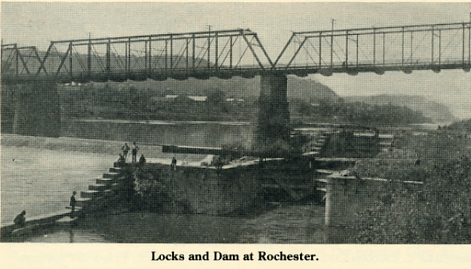
Click Here to Return to Milestones

A detailed account of the great canal celebration, on July 28, 1831, to break the ground for the Beaver section of the Pennsylvania canal, is contained in the Western Argus of July 29, 1831. The ground was broken by soldiers of the Revolution amid the firing of cannon and the cheers of a large assemblage.
The canal, while it lasted, was a great blessing. Freight was shipped to Cleveland from Pittsburgh by way of Bridgewater, and up through the Beaver and Mahoning rivers. This water route required 144 locks.
A sketch of the old canal and what it did for Bridgewater, written by Mr. Reeves, was published in the issue of August 3, 1906.
Mr. Reeves says he took an active part in handling the traffic on the Beaver and Erie canal, which proved profitable in spite of the fact that freight was carried from Pittsburgh down the Ohio river to Bridgewater, then up the Beaver and Mahoning rivers, at what seems now to be a ridiculously slow rate. Iron and glass were the principal products carried from Pittsburgh to Erie and Cleveland. From Ravenna, the highest point on the canal, the greater portion of the freight consisted of cheese from the western reserve of Ohio. The rate was $1.50 a ton.
The canal boats had a capacity of about 60 tons. It required three of the lake steamers of that date to take careof the freight loaded on one of these canal boats. The crew consisted of the captain, bowsman, two steersmen and two drivers. Lockage had to be paid to both the states of Ohio and Pennsylvania, and notwithstanding this a profitable business was done at the $1.50 a ton rate.
At Mahoningtown was located the junction of the two canals. One branch went to Cleveland and the other to Erie. It required six days to make the trip from Pittsburgh to Cleveland. Stops were made to take on and put off freight at the following towns: Beaver, Bridgewater, New Brighton, Beaver Falls, Mahoningtown, Edenburg, Lowell, Youngstown, Niles, Warren, Newton Falls, Ravenna and Akron, where the Ohio canal was utilized to Cleveland. It was on this canal that President James A. Garfield, when a boy, drove a boat mule. The stops between Mahoningtown and Erie were: New Castle, Pulaski, Greenville, Jamestown, Albion, Girard and Fairview.
The Bunker Hill was one of the largest canal boats, and frequently brought 11,000 cheese from Ravenna to Pittsburgh. With the building of the big canal all this business will be revived, but on a much larger scale. With history, in a measure repeating itself, all the towns between Pittsburgh and Warren will be given a new impetus. The section between Niles and Ashtabula will naturally undergo a wonderful development.
Mr. Reeves says also that packet lines for carrying passengers were operated. His brother Joseph and Daniel Wallace were associated with him in a line from New Castle to Pittsburgh. They built the packet Ontario, which was drawn by two horses, and accommodated about 50 passengers. These would be taken on at New Castle in the evening and landed at Bridgewater the next morning. The fare was 50c which included a bed.
History in a way will repeat itself in Bridgewater with the building of the Lake Erie & Ohio Ship canal. The town was once the terminal for an enormous canal boat business. It was here that the freight was transferred from the canal boats to the Ohio river steamers and vice versa. The town is located at the mouth of the Beaver river and is one of the most advantageous points on the route for the proposed big canal.
Bridgewater was laid out under the same act of Legislature as was Beaver, that of September 28, 1791. It was a reservation of the State in lots of 10 acres. The land was purchased by Judge Alexander Addison, the deed being on record in the court house at Beaver. His heirs sold a big portion of it to James W. Hemphill, in 1831, about the time the Beaver & Erie Canal was an assured fact.
Then the place began to thrive. Warehouses were erected and it was no uncommon sight to see the mouth of the Beaver river filled with canal boats, laden with freight from Lake Erie points, with the noses of Ohio river steamers touching then, and having freight transferred, destined to Pittsburgh and Southern points.
The most important business and manufacturing plants of these early days were foundries. One was known as the Bannon foundry and the other was operated by Robert Darragh, grandfather of former Judge Edwin H. Stowe of Pittsburgh. Commission and forwarding firms were numerous and there was great competition in business.